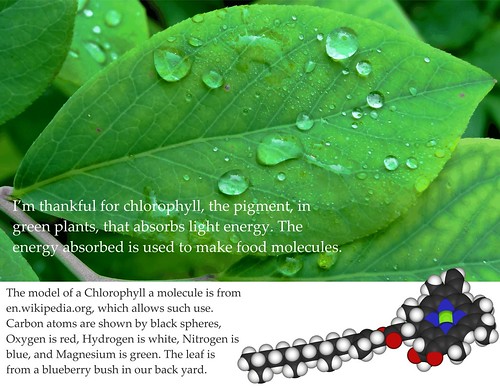
The picture above is of a blueberry leaf, and of one version of a model of a Chlorophyll molecule.
A recent post attempted to explain why we should be thankful for Carbon atoms, which are able to form complex structures. A Chlorophyll molecule isn't nearly as complex as DNA, or as a protein, but it's pretty complex. The Wikipedia article on Chlorophyll says that Chlorophyll a has this chemical structure: C55H72O5N4Mg. That's 137 atoms, of 5 different elements. Without the capacity of Carbon to form such structures, life would be impossible. (Chlorophyll a is the most common Chlorophyll molecule. Chlorophyll b, which is very similar, is also found in green plants. Other similar molecules are found in other types of organisms.)
Life requires energy sources. For most living things, certainly including us, Chlorophyll is essential in making such energy available. How does it do this? It is a pigment. Like all pigments, it absorbs certain types of light. Light is a form of energy. Before we get to the energy, let's consider the color of Chlorophyll. It's green. So what? That means that it is not absorbing green light. Green light is being reflected from the leaves that contain Chlorophyll, or it is passing through them. It's other colors of light that Chlorophyll absorbs. (That's true of all pigments -- a red pigment, for example, does not absorb red light. It reflects it.) Chlorophyll absorbs the energy of blue and red, or far red, light.
What does Chlorophyll do with this energy? It makes it available to photosynthesis, the process, as the name suggests, whereby light energy is used to make things. What is made is simple sugars, which are used for food, and also as raw materials for making other types of molecules needed by living things.
Photosynthesis requires two raw materials, water (H2O) and Carbon dioxide (CO2). The energy absorbed by Chlorophyll is used to break water molecules, so that Hydrogen is available. In the process, Oxygen is given off. See here for the summary chemical equation for photosynthesis. It is only a summary. The process is complex. That Hydrogen becomes attached to Carbon, from the Carbon Dioxide, and the result is glucose (C6H12O6).
The food we eat, where food is an energy source usable by our body's metabolism, all comes from green plants, directly or indirectly. It comes from plants like beans and spinach, or from animals that eat green plants, like cows, or, rarely, from animals that eat animals that eat green plants, such as some fish.
The three-dimensional structure of Chlorophyll makes it possible for it to trap light energy, and divert it into chemical energy -- food. I believe, but cannot prove, that God designed Carbon atoms, and also Hydrogen, Oxygen, Nitrogen and Magnesium atoms, so that they could be assembled into Chlorophyll molecules, thus making it possible for green plants to get food, and for us to get food from them. I also believe that He planned and designed the complex enzymes that construct Chlorophyll, and that assist in transferring captured light energy to chemical bonds. As I say, I can't prove any of this, but no one can disprove it, either.
Thanks for reading. Be grateful for photosynthesis.


2 comments:
Chlorophyll, the vibrant green pigment found in plants, is a key part of plant survival and its growth process. Through photosynthesis, this transformation of sunlight into energy is responsible for life on Earth.
True. Thanks.
Post a Comment